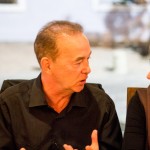My favorite part of the trip happened at the end of our tour, when we visited the Kallari cooperative in the the Amazonian rain forest. The trip began with a long but beautiful ride into the eastern part of the country. The air got thicker, the roads bumpier and the conversation deeper (it was a 6 hour drive so we discussed chocolate — a lot). I was thrilled to be heading into the heart of cacao country. According to studies tracing the origins of cacao, Theobroma cacao is native to exactly where we were heading, the Amazon basin.
We were here to visit a cooperative of indigenous people living in the Napo region of the Amazon called the Kallari cooperative. They harvest, make and market their own chocolate. The Kallari story is a fascinating one. It began in 1997 when a group of Quichwa leaders decided to help local farmers to earn more money for their beans. With the help of Judy Logback, an environmentalist and volunteer working in the region, they began selling the beans directly while improving on their fermentation and drying techniques. Several years later, they decided to take it a step further and actually began making their own chocolate. They asked John Steinberg, one of the founders of Sharfenberger chocolate to help them develop their first prototype bar and the first shipment of bars went out in 2008.
To learn more about Kallari’s journey, and the people involved, check out these two articles.
http://www.nytimes.com/2008/11/05/dining/05choc.html?pagewanted=all&_r=0
http://www.sagemagazine.org/pdf/sage4-1.pdf
Shortly after arriving at our Amazon lodge, we visited the Kallari headquarters to watch a slide show presentation about the cooperative and to taste some chocolate. Prior to this visit, we had toured the chocolate factory in Quito that manufactures the Kallari bars. When I tasted the bars then and I liked them a lot. The chocolate is mellow and fruity with an excellent mouthfeel that signifies good conching techniques and a high cocoa butter content.
The opportunity to see this cooperative in action in the region where the cacao is grown, really made me feel connected to the chocolate. As a result, it tasted even better than before. It just goes to show that the story behind a food is very important in increasing your pleasure of it.
On the itinerary for the next day was a visit to a traditional family farm. The Quichwa use a system of agriculture called chakra where different crops are planted alongside each other to promote biodiversity. Next to cacao plants were medicinal plants, vegetable ivory, and tropical fruits, such as coconuts, and plantains. I learned that this system is also a way to preserve a traditional way of life that is threatened more and more by the encroaching western culture and economic pressure. For example, if the Quichwa families didn’t make a secure income from selling their beans, they would probably resort to logging vital Amazonian trees as a way to make money. This destruction of the forest threatens their environment, and hence, their way of life.
The very last stop before heading back into Quito (and our farewell dinner) was a tour of the cocoa collection center. Unlike some of the others we’d seen, this one was clean, well organized and busy. I saw a lot of pride in the people working here just like I had seen in the workers on the farm and in the office the day before. It struck me that Kallari could be a really great model for other cooperatives in other cocoa growing regions. Instead of being at the mercy of multi-national companies who force down the price paid to cooperatives for their beans, the Kallari cooperative retain 100% of their profits from the finished chocolate, the Kallari bars, all of which go directly back to their members. That is a massive achievement and definitely something to be proud about!

























